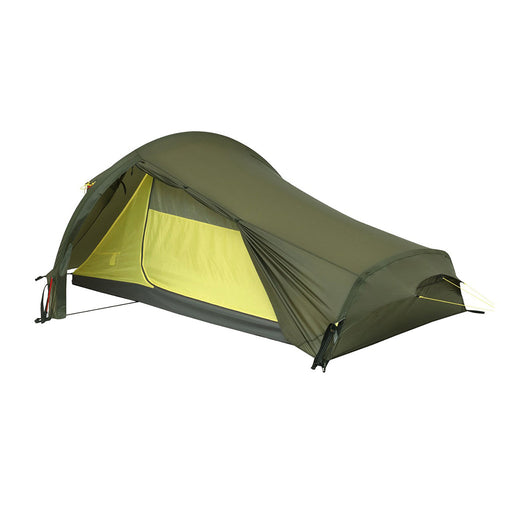
Tents | Expedition
If you're heading into the unknown, you will want to be prepared for whatever the Australian weather gods might throw at you. At Tom's Outdoors, we stock a range of extreme tents that will effortlessly handle all 4-season conditions
Click here to read more...
THINGS TO CONSIDER WHEN BUYING AN EXPEDITION TENT
When buying an expedition tent, it’s crucial to consider its design and structure. Opt for dome or geodesic designs, which provide excellent stability in high winds and heavy snow. In Australian conditions, this stability is particularly important for withstanding coastal winds, outback storms, or alpine weather. Look for high-quality poles made from aluminium or other durable materials, as these offer more stability and longevity in diverse environments. Tents with vestibules are ideal for gear storage, keeping the interior space clear and providing extra protection from the elements like rain, sand, or debris often encountered in Australia.
Weather resistance: is key for any tent, but even more so when dealing with the unpredictability of Australian weather. The tent should have a low-profile, aerodynamic shape with a strong pole structure to withstand the gusty winds common in the Outback or along the coast. It should also be capable of handling heavy snow loads if you plan to camp in snowy conditions, such as in the Australian Alps. A good waterproof rating, measured in millimetres of hydrostatic head (2000mm+), is essential for withstanding heavy rain, which can be sudden and torrential in tropical regions or during the wet season in the Northern Territory. A full-coverage rainfly that extends to the ground provides the best protection against rain, snow, wind, and even the occasional dust storm.
Ventilation: is particularly crucial in Australia, where temperatures can vary dramatically between day and night. To prevent condensation and overheating, look for tents with adjustable vents, mesh panels, or windows. A combination of breathable inner fabric and a waterproof outer layer helps manage moisture effectively and provides comfort during hot summer nights or humid conditions in places like Queensland or the Northern Territory.
Weight and packability: should be carefully considered, especially if you plan on trekking or backpacking across Australia's varied terrain, from rugged mountain ranges to expansive deserts. Expedition tents are typically heavier due to their durability, but finding a balance between sturdiness and weight is important, particularly if you will carry the tent over long distances or in challenging conditions. Also, check the tent’s pack size to ensure it fits well in your backpack or expedition gear.
Space and capacity: are essential for comfort, especially on longer trips. Make sure the tent offers enough room for the number of people and gear you plan to accommodate. Consider the peak height, floor area, and space for sitting or moving around, which can be especially important during long spells of bad weather. In Australian conditions, a tent rated for two people might feel cramped with all your gear, particularly in colder regions where more equipment is needed. Sizing up can provide added comfort.
Durability: is vital, particularly when dealing with the diverse and often harsh Australian landscape. High-denier fabrics (such as 70D or higher) for the floor and canopy will help resist tears and abrasions from rough ground or thorny vegetation. Reinforced seams, either taped or welded, prevent leaks and increase overall strength, which is crucial when facing sudden downpours or strong winds. High-quality zippers and hardware are also important for reliability in harsh conditions, where gear failure is not an option.
Ease of setup: is a key factor, especially in rapidly changing weather or at the end of a long day of trekking. Look for a tent with a simple pole system that is quick and easy to assemble, even in adverse weather. Features like color-coded poles and clips can make setup faster. Freestanding tents are generally easier to set up and can be moved around before staking, which is particularly useful when you need to adjust positioning in response to changing winds or ground conditions.
Additional features like a footprint or groundsheet can protect the tent floor from abrasion and extend its lifespan, especially on rough or abrasive surfaces like rocky outcrops or sandy beaches. Reflective guy lines enhance visibility at night and improve safety, while a repair kit is handy for fixing minor issues in the field. In Australian conditions, it is also helpful to have insect-proof mesh to keep out bugs and flies, which can be a major nuisance in some areas.
Finally, think about the tent's intended use. For camping in winter or extreme conditions, choose a tent rated for four seasons. Also, consider the specific environments where you will use the tent, such as high altitudes like the Snowy Mountains, snow-covered regions in winter, or the arid deserts and coastal areas where conditions can shift rapidly.
NEED HELP CHOOSING YOUR NEXT TENT? CONTACT US TODAY
If you have a particular tent in mind but would appreciate some additional advice. Simply get in touch with our friendly sales team – they’re always up for a chat. You can contact us by calling our Tumut store on (02) 6947 4062 or by email.
Helsport Ringstind Pro 2 - Lightweight 4-Season Tent
HelsportThe Ringstind is what happens when you combine minimalism with four season capabilities. The 2-person tent is exceptionally user-friendly, thanks t...
View full details

